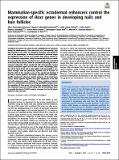Por favor, use este identificador para citar o enlazar a este item:
http://hdl.handle.net/10261/231395COMPARTIR / EXPORTAR:
 SHARE SHARE
 CORE
BASE CORE
BASE
|
|
| Visualizar otros formatos: MARC | Dublin Core | RDF | ORE | MODS | METS | DIDL | DATACITE | |

| Título: | Mammalian-specific ectodermal enhancers control the expression of Hoxc genes in developing nails and hair follicles |
Autor: | Fernández-Guerrero, Marc CSIC; Yakushiji-Kaminatsui, Nayuta; Lopez-Delisle, Lucille; Zdral, Sofía CSIC ORCID; Darbellay, Fabrice; Pérez-Gómez, Rocío CSIC; Chase Bolt, Christopher; Sanchez-Martin, Manuel A.; Duboule, Denis; Ros, María A. CSIC ORCID | Palabras clave: | Hox genes Enhancers Nails Hair follicles, Transcription |
Fecha de publicación: | 1-dic-2020 | Editor: | National Academy of Sciences (U.S.) | Citación: | Proceedings of the National Academy of Sciences of the United States of America 117(48): 30509-30519 (2020) | Resumen: | Vertebrate Hox genes are critical for the establishment of structures during the development of the main body axis. Subsequently, they play important roles either in organizing secondary axial structures such as the appendages, or during homeostasis in postnatal stages and adulthood. Here, we set up to analyze their elusive function in the ectodermal compartment, using the mouse limb bud as a model. We report that the HoxC gene cluster was co-opted to be transcribed in the distal limb ectoderm, where it is activated following the rule of temporal colinearity. These ectodermal cells subsequently produce various keratinized organs such as nails or claws. Accordingly, deletion of the HoxC cluster led to mice lacking nails (anonychia), a condition stronger than the previously reported loss of function of Hoxc13, which is the causative gene of the ectodermal dysplasia 9 (ECTD9) in human patients. We further identified two mammalian-specific ectodermal enhancers located upstream of the HoxC gene cluster, which together regulate Hoxc gene expression in the hair and nail ectodermal organs. Deletion of these regulatory elements alone or in combination revealed a strong quantitative component in the regulation of Hoxc genes in the ectoderm, suggesting that these two enhancers may have evolved along with the mammalian taxon to provide the level of HOXC proteins necessary for the full development of hair and nail. | Descripción: | © 2020 the Author(s). | Versión del editor: | http://dx.doi.org/10.1073/pnas.2011078117 | URI: | http://hdl.handle.net/10261/231395 | DOI: | 10.1073/pnas.2011078117 | ISSN: | 0027-8424 | E-ISSN: | 1091-6490 |
| Aparece en las colecciones: | (IBBTEC) Artículos |
Ficheros en este ítem:
| Fichero | Descripción | Tamaño | Formato | |
|---|---|---|---|---|
| Mammalian_Fernandez_PV_Art2021.pdf | 2,32 MB | Adobe PDF |  Visualizar/Abrir |
CORE Recommender
PubMed Central
Citations
9
checked on 17-mar-2024
SCOPUSTM
Citations
13
checked on 16-abr-2024
WEB OF SCIENCETM
Citations
14
checked on 27-feb-2024
Page view(s)
85
checked on 22-abr-2024
Download(s)
89
checked on 22-abr-2024

